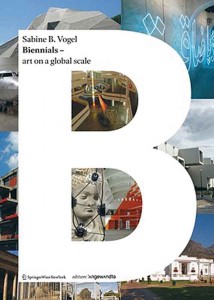« Related Readings
Biennials – Art on a Global Scale
 Vogel, Sabine B. Biennials - Art on a Global Scale. Vienna-New York: Springer, 2010. 142 pages. ISBN 9783709102503
Vogel, Sabine B. Biennials - Art on a Global Scale. Vienna-New York: Springer, 2010. 142 pages. ISBN 9783709102503
By Paco Barragán
I once wrote that the 1990s was the age of the biennials, and the first decade of the 21st century the art fair age. Have biennials disappeared? Have art fairs disappeared? To both questions, “no” is the answer, but we can come to the conclusion that biennials have remained more or less stable in numbers, and art fairs, once reaching their apex in 2008, have started to disappear more quickly with the dawning of the economy.
If biennials haven’t increased strongly in numbers, what has been an unstoppable presence in most recent years are panels, conferences, and books about biennials. You could even say there is a biennial fever or “biennalogy.” Among the many books that have appeared in the art market, we find Biennials: Art on a Global Scale written by Sabine B. Vogel, art critic and lecturer at the University of Applied Arts Vienna, Austria.
The book is divided in three parts. Part One is ‘The First Phase-Biennials in the Age of Modernity,’ in which the author addresses the creation of the la Biennale di Venezia as the first biennial and then engages in other later biennials of the 20th century, like Documenta, Bienal de Sao Paulo (1950s), Triennale India and Biennale of Sydney (1960s and 70s), and Cairo Biennale, Bienal de la Habana, and International Istanbul Biennial (1980s). Part Two is ‘The Second Phase-Biennials in the Age of Globalization,’ which engages with the new globalization context and the emergence of biennials in the 90s, like DAK’ART, Johannesburg Biennale, Sharjah Biennale, Taipei Biennale, Riwaq Biennale, Shanghai Biennale, Gwangju Biennale, Manifesta, Berlin Biennale for Contemporary Art, and biennials of the new millennium, like Thessaloniki Biennale, Athens Biennale, Moscow Biennale, and Singapore Biennale. Part Three, the conclusion, tackles ‘Potential and Limitations of Biennials.’ The book also offers an ‘Appendix’ with a list of new biennials, curators and directors of biennials, and literature. So far so good.
“Don’t judge a book by its cover,” (sung by British group ABC in the 80s), and I would add “judge it by its introduction.” The fact is that after reading the book I still don’t have a clear opinion of whether biennials are necessary or superfluous art platforms, marketing tools or important social transformation elements. And this is because the tone in the book is very flat and the author dedicates herself from the preface on to enumerate biennials and facts, some of them rather hilarious, like the fact that the OK Centrum in Linz holds the Biennale Cuvee once a year, in which a “selection of exceptional works from various international biennials are shown.”
When we address such a polemic topic, like the biennial as artistic platform and its validity today, I would expect authors to ask themselves if a biennial is still an articulated discourse for the idea of progress and utopia or just a branding tool to bring in high-end tourism. They should also question the unstoppable commodification that makes the biennial behave like a de facto art fair. This doesn’t happen, and the book is no more than a vade mecum good for students. And this is a pity!


































